15 Climate Change
Learning Objectives
After studying this chapter, you should be able to:
- Explain how the greenhouse effect warms the earth
- Differentiate between global warming and global climate change
- Summarize the evidence for anthropogenic climate change
- Explain how human activities contribute to global climate change
- List current effects and predicted future effects of climate change
- Describe actions that can be taken to manage climate change
Earth’s Temperature is a Balancing Act
Earth’s temperature depends on the balance between energy entering and leaving the planet. When incoming energy from the sun is absorbed, Earth warms. When this energy is released back into space, Earth cools. Many factors, both natural and human, can cause changes in Earth’s energy balance, including:
- Changes in the greenhouse effect, which affects the amount of heat retained by Earth’s atmosphere
- Variations in the sun’s energy reaching Earth
- Changes in the reflectivity of Earth’s atmosphere and surface
Scientists have pieced together a picture of Earth’s climate, dating back hundreds of thousands of years, by analyzing a number of indirect measures of climate such as ice cores, tree rings, glacier size, pollen counts, and ocean sediments. Ice cores from polar regions are especially useful sources of climate data because they can contain thousands of years’ worth of ice laid down in layers, much like the rings of a tree. These layers of ice trap atmospheric gases that tell us a great deal about the temperature and other climate factors from the past (Figure 1). Scientists have also studied changes in Earth’s orbit around the sun and the activity of the sun itself.

The historical record shows that the climate varies naturally over a wide range of time scales. Periods of high heat are followed by periods of extreme cold, known as ice ages. Until the Industrial Revolution of the 1700s, these temperature fluctuations could be fully explained by natural causes such as volcanic activity or changes to the sun’s output. However, the average temperature of the earth has been increasing at an unusually rapid rate since at least the late 1800s (Figure 2), and this recent warming period is largely explained by the effects of human actions.
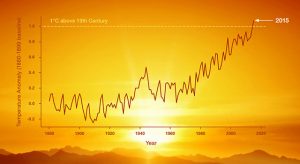
Global Climate Change
When sunlight reaches Earth’s surface, it can either be reflected back into space or absorbed by Earth. Once absorbed, the planet releases some of the energy back into the atmosphere as heat (in the form of infrared radiation). Greenhouse gases (GHGs) like water vapor (H2O), carbon dioxide (CO2), and methane (CH4) absorb infrared radiation and reflect much of it back to the earth’s surface, thus slowing or preventing the loss of heat to space. In this way, GHGs act like a blanket, making Earth warmer than it would be if there were no atmosphere. This process is commonly known as the greenhouse effect (Figure 3). Levels of greenhouse gases fluctuate naturally over time, but human activities have increased the amounts of several GHGs since the Industrial Revolution.
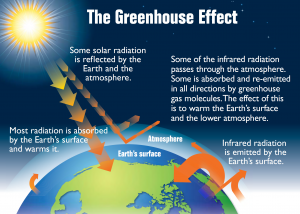
The earth naturally cycles through periods of warmer and cooler average temperatures over the course of thousands of years. We are currently experiencing a period of global warming, or a rise in global average temperature near the earth’s surface. This warming trend is influenced by natural causes, as discussed below, but the largest contributor is the increase in greenhouse gases from human activities. The increasing temperature is, in turn, having an effect on many other climate factors, such as precipitation, wind patterns, and storm frequency. These effects are collectively known as global climate change.
Knowledge Check
Greenhouse Gases
The most important GHGs directly emitted by humans include CO2, methane, nitrous oxide (N2O), fluorinated gases, and water vapor. The global warming potential (GWP) of a greenhouse gas is a measure of how much heat the gas is able to trap in the atmosphere, while the relative warming effect takes into account the gas’s concentration in the atmosphere. A gas with a high GWP may have a low relative warming effect if it is found in very small amounts in the atmosphere (Figure 4). The sources and recent trends of these gases are detailed below.
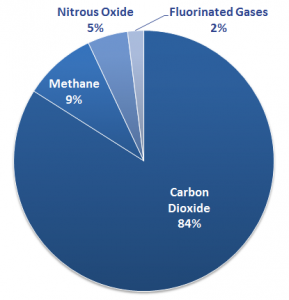
Carbon dioxide (CO2) is the primary greenhouse gas that is contributing to recent climate change. Although it has a lower global warming potential than other GHGs because it holds less heat, CO2 has a higher relative warming effect because it is much more abundant in the atmospere (see Figure 4). CO2 is absorbed and emitted naturally as part of the carbon cycle, through respiration, volcanic eruptions, and ocean-atmosphere exchange. Human activities, such as the burning of fossil fuels and deforestation, release large amounts of carbon dioxide into the atmosphere. Atmospheric CO2 concentrations have increased by almost 40% since pre-industrial times, from approximately 280 parts per million (ppm) in the 18th century to 410 ppm in 2018. The current CO2 level is higher than it has been in at least 800,000 years. Some volcanic eruptions released large quantities of CO2 in the distant past. However, the U.S. Geological Survey (USGS) reports that human activities now emit more than 135 times as much CO2 as volcanoes each year. Human activities currently release over 30 billion tons of CO2 into the atmosphere every year. This build-up in the atmosphere is like a tub filling with water, where more water flows from the faucet than the drain can take away.
Methane (CH4) has a much higher global warming potential than CO2: one ton of methane can absorb 23 times more heat than one ton of carbon dioxide. However, the relative warming effect of methane is lower than CO2 because there is less of it in the atmosphere (about 1800 parts per billion). Methane can be emitted naturally from wetlands and other sources, but the concentrations have increased sharply due to human activity. Animal agriculture is one of the largest human-caused sources of methane because methane-producing bacteria thrive in the guts and manure of livestock. Methane is more abundant in Earth’s atmosphere now than at any time in at least the past 650,000 years. Due to human activities, CH4 concentrations increased sharply during most of the 20th century and are now more than two and-a-half times pre-industrial levels.
Nitrous oxide (N2O) has a global warming capacity that is 300 times greater than carbon dioxide, but it too has a lower relative warming effect due to its low concentration in the atmosphere (about 330 parts per billion). The largest human source of N2O is agriculture, especially the use of synthetic fertilizers and mismanagement of animal manure.
Fluorinated gases (F-gases) are GHGs that are created entirely by humans and have a very high global warming potential (from 140 to 22,000 times stronger than CO2!). Several of these compounds were created as substitutes for chlorofluorocarbons because they do not harm the ozone layer. But they are now regulated in many countries due to their negative impact on the climate.
Water vapor is the most abundant greenhouse gas and also the most important in terms of its contribution to the natural greenhouse effect, despite having a short atmospheric lifetime. However, on a global scale, the concentration of water vapor is heavily controlled by temperature, which influences overall rates of evaporation and precipitation. Therefore, the global concentration of water vapor is not substantially affected by human activity.
Knowledge Check
Other Causes of Climate Change
Solar Activity
In addition to the greenhouse effect, the earth’s climate is influenced by natural changes that affect how much solar energy reaches Earth. These changes include changes within the sun and changes in Earth’s orbit. Changes occurring in the sun itself can affect the intensity of the sunlight that reaches Earth’s surface. The intensity of the sunlight can cause either warming (during periods of stronger solar intensity) or cooling (during periods of weaker solar intensity). The sun follows a natural 11-year cycle of small ups and downs in intensity, but the effect on Earth’s climate is small. Changes in the shape of Earth’s orbit as well as the tilt and position of Earth’s axis can also affect the amount of sunlight reaching Earth’s surface.
Changes in the sun’s intensity have influenced Earth’s climate in the past. For example, the so-called “Little Ice Age” between the 17th and 19th centuries may have been partially caused by a low solar activity phase from 1645 to 1715, which coincided with cooler temperatures. The “Little Ice Age” refers to a slight cooling of North America, Europe, and probably other areas around the globe. Changes in Earth’s orbit have had a big impact on climate over tens of thousands of years. These changes appear to be the primary cause of past cycles of ice ages, in which Earth has experienced long periods of cold temperatures (ice ages), as well as shorter interglacial periods (periods between ice ages) of relatively warmer temperatures.
Changes in solar energy continue to affect climate. However, solar activity has been relatively constant, aside from the 11-year cycle, since the mid-20th century and therefore does not explain the recent warming of Earth. Similarly, changes in the shape of Earth’s orbit as well as the tilt and position of Earth’s axis affect temperature on relatively long timescales (tens of thousands of years), and therefore cannot explain the recent warming. As seen in Figure 5, solar activity has actually decreased in the current century, while the earth continues to warm.
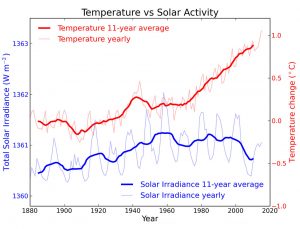
Changes in Reflectivity
When sunlight reaches Earth it can be reflected or absorbed. The amount that is reflected or absorbed depends on Earth’s surface and atmosphere. Light-colored objects and surfaces, like snow and clouds, tend to reflect most sunlight, while darker objects and surfaces, like the ocean, forests, or soil, tend to absorb more sunlight. The term albedo refers to the amount of solar radiation reflected from an object or surface, often expressed as a percentage. Earth as a whole has an albedo of about 30%, meaning that 70% of the sunlight that reaches the planet is absorbed. Absorbed sunlight warms Earth’s land, water, and atmosphere.
Albedo is also affected by aerosols. Aerosols are small particles or liquid droplets in the atmosphere that can absorb or reflect sunlight. Unlike greenhouse gases (GHGs), the climate effects of aerosols vary depending on what they are made of and where they are emitted. Those aerosols that reflect sunlight, such as particles from volcanic eruptions or sulfur emissions from burning coal, have a cooling effect. Those that absorb sunlight, such as black carbon (a part of soot), have a warming effect.
Natural changes in albedo, like the melting of sea ice or increases in cloud cover, have contributed to climate change in the past, often acting as feedbacks to other processes. Volcanoes have played a noticeable role in climate. Volcanic particles that reach the upper atmosphere can reflect enough sunlight back to space to cool the surface of the planet by a few tenths of a degree for several years. Volcanic particles from a single eruption do not produce long-term change because they remain in the atmosphere for a much shorter time than GHGs.
Human changes in land use and land cover have changed Earth’s albedo. Processes such as deforestation, reforestation, desertification, and urbanization often contribute to changes in climate in the places they occur. These effects may be significant regionally, but are smaller when averaged over the entire globe.
The Scientific Consensus on Climate Change
Knowledge Check
Future Climate Change
Greenhouse gas concentrations in the atmosphere will continue to increase unless the billions of tons of anthropogenic (human-caused) emissions each year decrease substantially. Increased GHG concentrations are expected to:
- Increase Earth’s average temperature
- Influence the patterns and amounts of precipitation
- Reduce ice and snow cover, as well as permafrost
- Raise sea level
- Increase the acidity of the oceans
These changes will impact our food supply, water resources, infrastructure, ecosystems, and even our own health. The magnitude and rate of future climate change will primarily depend on the following factors:
- The rate at which levels of greenhouse gas concentrations in our atmosphere continue to increase
- How strongly features of the climate (e.g., temperature, precipitation, and sea level) respond to the expected increase in greenhouse gas concentrations
- Natural influences on climate (e.g., from volcanic activity and changes in the sun’s intensity) and natural processes within the climate system (e.g., changes in ocean circulation patterns)
Many greenhouse gases stay in the atmosphere for long periods of time. As a result, even if emissions stopped increasing, atmospheric greenhouse gas concentrations would continue to increase and remain elevated for hundreds of years. Moreover, if we stabilized concentrations and the composition of today’s atmosphere remained steady (which would require a dramatic reduction in current greenhouse gas emissions), surface air temperatures would continue to warm. This is because the oceans, which store heat, take many decades to fully respond to higher greenhouse gas concentrations. The ocean’s response to higher greenhouse gas concentrations and higher temperatures will continue to impact climate over the next several decades to hundreds of years.
Future Temperature Changes
Climate models project the following key temperature-related changes:
Key Global Projections
- Average global temperatures are expected to increase by 2°F to 11.5°F by 2100, depending on the level of future greenhouse gas emissions, and the outcomes from various climate models.
- By 2100, global average temperature is expected to warm at least twice as much as it has during the last 100 years.
- Ground-level air temperatures are expected to continue to warm more rapidly over land than oceans.
- Some parts of the world are projected to see larger temperature increases than the global average.
Future Precipitation and Storm Events
Patterns of precipitation and storm events, including both rain and snowfall are likely to change. However, some of these changes are less certain than the changes associated with temperature. Projections show that future precipitation and storm changes will vary by season and region. Some regions may have less precipitation, some may have more precipitation, and some may have little or no change. The amount of rain falling in heavy precipitation events is likely to increase in most regions, while storm tracks are projected to shift towards the poles. Climate models project the following precipitation and storm changes
Key Global Projections
- Global average annual precipitation through the end of the century is expected to increase, although changes in the amount and intensity of precipitation will vary by region.
- The intensity of precipitation events will likely increase on average. This will be particularly pronounced in tropical and high-latitude regions, which are also expected to experience overall increases in precipitation.
- The strength of the winds associated with tropical storms is likely to increase. The amount of precipitation falling in tropical storms is also likely to increase.
- Annual average precipitation is projected to increase in some areas and decrease in others.
Future Ice, Snowpack, and Permafrost
Arctic sea ice is already declining drastically, as seen in Figure 6. The area of snow cover in the Northern Hemisphere has decreased since 1970. Permafrost has decreased over the last century as warmer temperatures cause the underground ice to thaw. Over the next century, it is expected that sea ice will continue to decline, glaciers will continue to shrink, snow cover will continue to decrease, and permafrost will continue to thaw. Potential changes to ice, snow, and permafrost are described below.
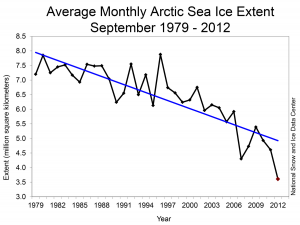
Key Global Projections
For every 2°F of warming, models project about a 15% decrease in the extent of annually averaged sea ice and a 25% decrease in September Arctic sea ice.The coastal sections of the Greenland and Antarctic ice sheets are expected to continue to melt or slide into the ocean. If the rate of this ice melting increases in the 21st century, the ice sheets could add significantly to global sea level rise. Glaciers are expected to continue to decrease in size. The rate of melting is expected to continue to increase, which will contribute to sea level rise.
Future Sea Level Change
Warming temperatures contribute to sea level rise by expanding ocean water, melting mountain glaciers and ice caps, and causing portions of the Greenland and Antarctic ice sheets to melt or flow into the ocean. Since 1870, global sea level has risen by about 8 inches. Estimates of future sea level rise vary for different regions, but global sea level for the next century is expected to rise at a greater rate than during the past 50 years. The contribution of thermal expansion, ice caps, and small glaciers to sea level rise is relatively well-studied, but the impacts of climate change on ice sheets are less understood and represent an active area of research. Thus it is more difficult to predict how much changes in ice sheets will contribute to sea level rise. Greenland and Antarctic ice sheets could contribute an additional 1 foot of sea level rise, depending on how the ice sheets respond.
Regional and local factors will influence future relative sea level rise for specific coastlines around the world. For example, relative sea level rise depends on land elevation changes that occur as a result of subsidence (sinking) or uplift (rising). Assuming that these historical geological forces continue, a 2-foot rise in global sea level by 2100 would result in the following relative sea level rise:
- 2.3 feet at New York City
- 2.9 feet at Hampton Roads, Virginia
- 3.5 feet at Galveston, Texas
- 1 foot at Neah Bay in Washington state
Relative sea level rise also depends on local changes in currents, winds, salinity, and water temperatures, as well as proximity to thinning ice sheets.
Future Ocean Acidification
Ocean acidification is the process of ocean waters decreasing in pH. Oceans become more acidic as carbon dioxide (CO2) emissions in the atmosphere dissolve in the ocean. This change is measured on the pH scale, with lower values being more acidic. The pH level of the oceans has decreased by approximately 0.1 pH units since pre-industrial times, which is equivalent to a 25% increase in acidity. The pH level of the oceans is projected to decrease even more by the end of the century as CO2 concentrations are expected to increase for the foreseeable future. Ocean acidification adversely affects many marine species, including plankton, mollusks, shellfish, and corals. As ocean acidification increases, the availability of calcium carbonate will decline. Calcium carbonate is a key building block for the shells and skeletons of many marine organisms. If atmospheric CO2 concentrations double, coral calcification rates are projected to decline by more than 30%. If CO2 concentrations continue to rise at their current rate, corals could become rare on tropical and subtropical reefs by 2050.
Spread of Disease
This rise in global temperatures will increase the range of disease-carrying insects and the viruses and pathogenic parasites they harbor. Thus, diseases will spread to new regions of the globe. This spread has already been documented with dengue fever, a disease the affects hundreds of millions per year, according to the World Health Organization. Colder temperatures typically limit the distribution of certain species, such as the mosquitoes that transmit malaria, because freezing temperatures destroy their eggs.
Not only will the range of some disease-causing insects expand, the increasing temperatures will also accelerate their lifecycles, which allows them to breed and multiply quicker, and perhaps evolve pesticide resistance faster. In addition to dengue fever, other diseases are expected to spread to new portions of the world as the global climate warms. These include malaria, yellow fever, West Nile virus, zika virus, and chikungunya.
Knowledge Check
Climate Justice
Our lives are connected to the climate. Human societies have adapted to the relatively stable climate we have enjoyed since the last ice age which ended several thousand years ago. A warming climate will bring changes that can affect our water supplies, agriculture, power and transportation systems, the natural environment, and even our own health and safety. These changes will disproportionately affect those who live in developing nations, especially in coastal areas. Demographers predict millions of the world’s poorest people will be left homeless by extreme weather, rising seas, and other affects of climate change, leading to mass migration. Climate justice activists argue that this inequality is unfair since developing nations have contributed the least to the causes of climate change but will be the most strongly impacted by its negative effects (Figure 7). Many argue that developed nations like the United States, Canada, and European countries must do more to support the people in the world’s poorest nations as they struggle with the hardships brought on by climate change.
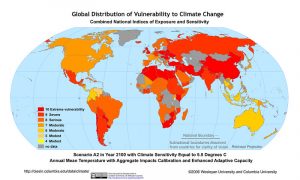
Carbon dioxide can stay in the atmosphere for nearly a century, so Earth will continue to warm in the coming decades. The warmer it gets, the greater the risk for more severe changes to the climate and Earth’s system. Although it’s difficult to predict the exact impacts of climate change, what’s clear is that the climate we are accustomed to is no longer a reliable guide for what to expect in the future.
By making choices that reduce greenhouse gas pollution, and preparing for the changes that are already underway, we can reduce risks from climate change. Our decisions today will shape the world our children and grandchildren will live in. You can take steps at home, on the road, and in your office to reduce greenhouse gas emissions and the risks associated with climate change. Many of these steps can save you money. Some, such as walking or biking to work, can even improve your health!
However, individual action will not be enough to slow down or stop global warming. Political action must be taken by governments from the local to the global level. Lobbying, protesting, and voting for politicians who support action on climate change are some of the ways individuals are influencing the political process to implement climate change policies.
Attribution
Essentials of Environmental Science by Kamala Doršner is licensed under CC BY 4.0. Modified from the original by Matthew R. Fisher and Sean Whitcomb.
Media Attributions
- Ice_core © UW News is licensed under a CC BY (Attribution) license
- Earth temperature graph © NASA/JPL-Caltech is licensed under a Public Domain license
- Earth’s_greenhouse_effect_(US_EPA,_2012) © U.S. EPA is licensed under a Public Domain license
- GHG_relative_warming © U.S. EPA is licensed under a Public Domain license
- Solar_radiation_graph © Skeptical Science is licensed under a CC BY (Attribution) license
- Average_Monthly_Arctic_Sea_Ice_Extent_-_September_1979_-_2012 © National Snow and Ice Data Center is licensed under a Public Domain license
- Climate change vulnerability map © SEDACMaps is licensed under a CC BY (Attribution) license

